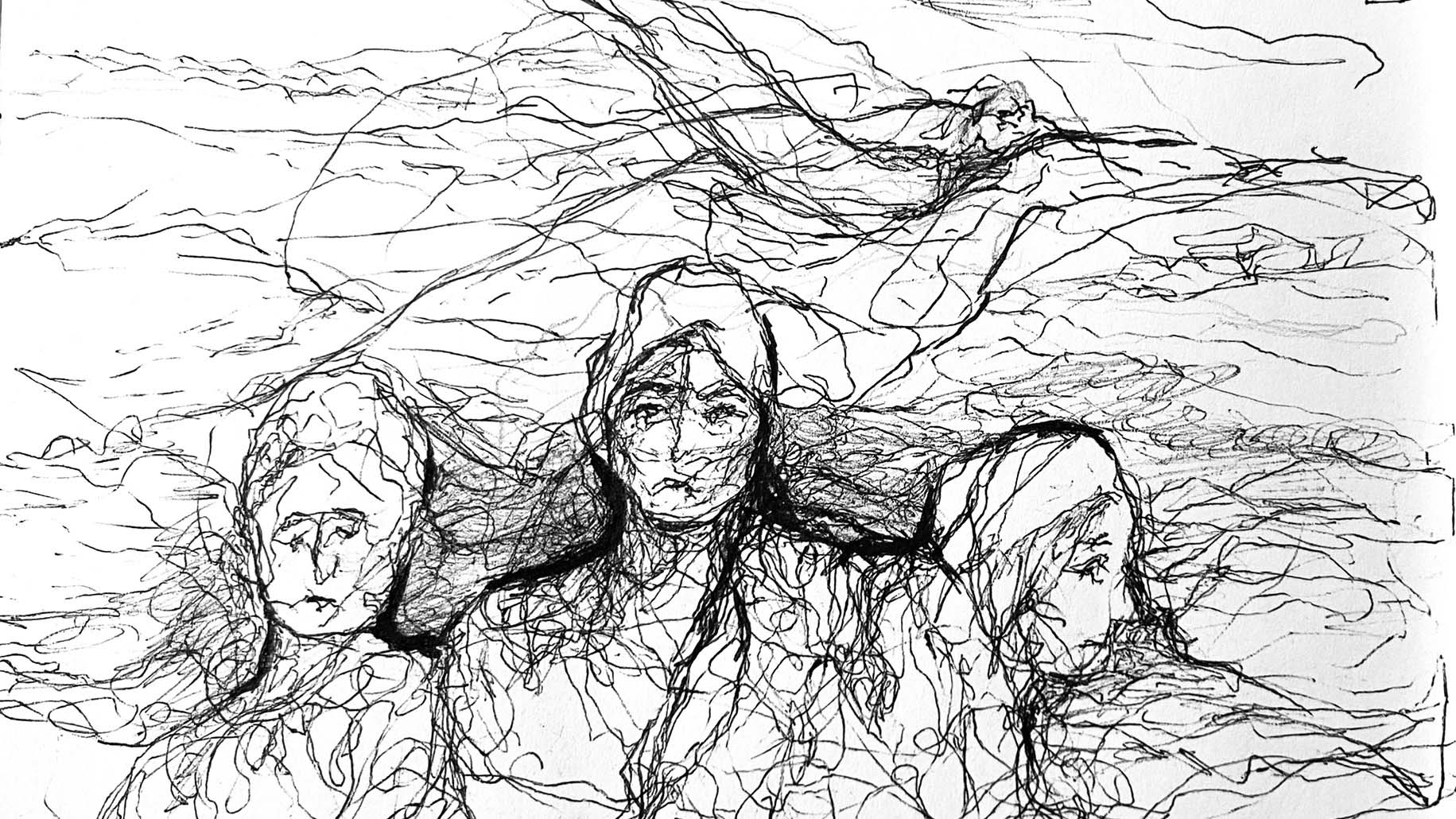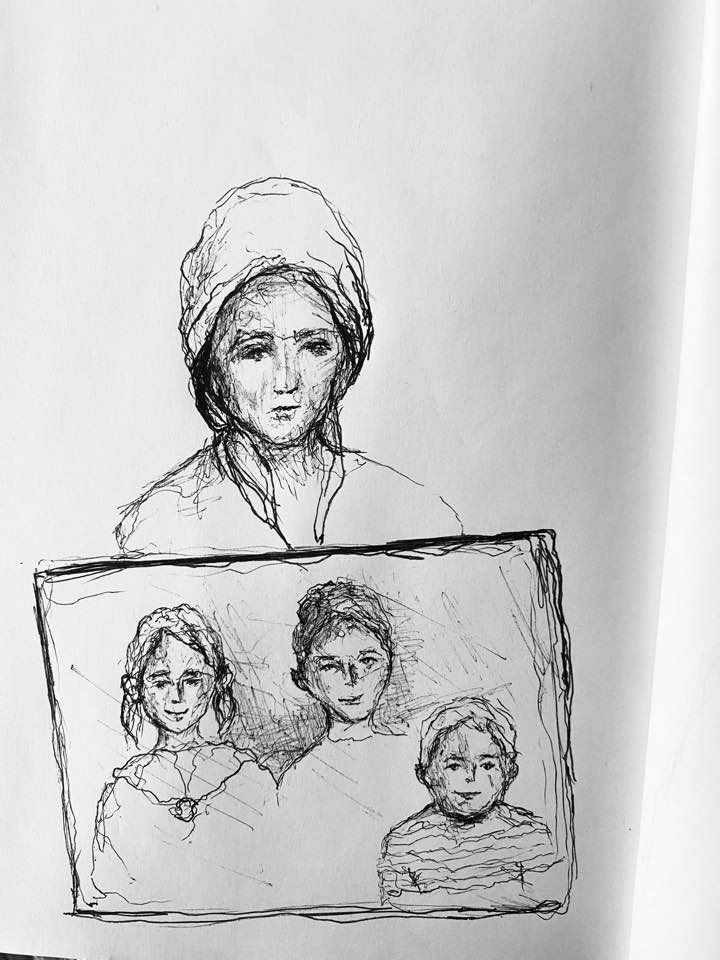Drawing under bombs: Gaza artist sketches portraits of victims of Israeli attack

When her neighbourhood was being bombed by Israeli warplanes in May last year, Rehaf al-Batniji, taking shelter in the basement of her home, was drawing portraits of the victims as she imagined them to be.
"I tried to imagine what each martyr would have been doing if his or her life was not snatched away from them," the Gaza native told Middle East Eye.
Stay informed with MEE's newsletters
Sign up to get the latest alerts, insights and analysis, starting with Turkey Unpacked
"If someone had a small tree they were taking care of, if they were sleeping or looking out the window, I imagined all that."
With a sketchbook that she kept with her during and in the aftermath of Israel's military campaign on the besieged Gaza Strip, Batniji drew 50 sketches of victims whose names and ages she had heard on the television.
The 31-year-old artist said she was "crying sketches," as drawing was the only way to "escape [horrible] news" and keep her from collapsing.
"During the war, you lose your stability, your feelings, and your humanity. This is their goal with these continuous attacks, to make you lose yourself. Maybe that's why I drew the sketches in black, which is something I did not plan for, they just came like that," Batniji said.
"There was something that was crushing me inside, a voice that I could never get rid of. I turned that voice into lines, and in some cases I didn't even know what I was drawing until I found out that I drew these faces."
Imagined faces
As Israeli shelling intensified during the 11-day campaign, Batniji's married siblings, her nieces and nephews all sought refuge in the family's house.
With everyone sheltering in one room in the basement, Batniji took occasional breaks from the chaos surrounding her by spending time in the small atelier in the home's front yard.
She shared her first sketch on her Facebook page on the fourth day of the military operation. Titled The Night Scene, the illustration depicts her family during the attacks.
"I kept thinking about the scene when my nieces and nephews hid from the bombing in their mothers' arms. It was my feelings that drew that sketch," Batniji said.
"If you noticed, even the mother who is supposed to protect [the children] is scared and wants to escape, but there is a bird above all of them."
Sketching was not only a tool for Batniji to find comfort amid the carnage. It also helped her deal with a feeling of helplessness. To her, the sketches were a way of "doing something for the victims" by keeping their names and stories alive.
Batniji said that none of the faces she drew belonged to people who were killed in the attacks, but they were how she "imagined their faces to be".
As the Palestinian death toll kept rising, reaching 259 by the end of the military campaign, Batniji was no longer drawing portraits only of people whose names she had heard on the news.
"This war was different because many of the martyrs we heard of were not distant, they were people we had met and knew, and they lived in the same area," she said.
"Among those were Riham al-Kolak, who was a friend of a friend... and Dima Saad, who was killed with her foetus in her womb and her two children around her.
"Every time these stories, our stories, turn into just numbers [in the news], I feel helpless, I feel psychologically unstable. Drawing these sketches helped me during the war only, only in that time, to deal with this crisis."
Craving calm
Batniji drew a sketch of Kolak, 33, who was killed by an Israeli air strike on her home in al-Wahda street in the middle of Gaza city. The air strike hit her home a few minutes after she posted a prayer for survival on Facebook.
"This was the sketch that most touched me, The Sleeping Lady, which I dedicated to the soul of Riham al-Kolak. I dedicated most of the sketches to child victims, but this one was different," Batniji said.
"When I drew this sketch, my mother was lying in front of me and telling me how horrible she felt for all the people who were gone. I just started drawing lines while she was talking. I don't know how they ended up to be this sketch. I imagined Riham in the drawing because she was almost my age, and I felt that connection between us.
"We usually need comfort, we need to feel safe and secure, so I drew her sleeping safely."
In four of the sketches she posted on Facebook during the attacks, Batniji drew different types of plants with the characters as an indication of calm and peace.
In her sketch dedicated to Dima Assaliya, 10, she drew a girl standing beside a pot of plants and staring out a window overlooking a dark scene of the chaos outside.
"This was one of the first scenes that I drew while thinking about calm during the war. Generally, we struggle for the idea of calm and peace in their broad meaning, but during the war, we start negotiating for half-an-hour of calm, half-an-hour of hiding," she said.
"While you try to hide, there is a very big window in front of you overlooking the smoke and noises of war. You try as much as you can to distance yourself from this scene and stay calm, and plants were one thing that I made sure to keep and take care of during the war to keep me calm."
Assaliya was killed on 19 May by an Israeli air strike while walking home from her sister's house after her mother had asked her to bring a small electric oven to bake home-made bread.
Child victims
Of the 259 Palestinians killed in Gaza by Israel in May, 66 were children, according to the Palestinian Health Ministry.
Following the offensive, nine out of 10 children in the coastal enclave were found to be suffering from some form of conflict-related post-traumatic stress disorder.
Most of Batniji's sketches illustrate the future of young victims as she imagined they would have been, because "they did not get the chance to make their own".
"People of our age had the chance to live part of their life and experience the meaning of it, but these children did not even know what life was."
While drawing sketches, Batniji would sometimes burst into tears thinking of the futures that these children might have had.
"Of the sketches I drew, one was for a child called Buthaina Ubaid. This girl was seven years old. What could we do for her? She was only seven, and her name just disappeared, her life was completely gone. What did the life she dreamed to live look like?
"I did not see Buthaina's picture and did not know what she looked like, I only knew how she was killed, so I imagined her face and drew her with a candle."
Ubaid died from her wounds on 14 May, which marked the second day of the Muslim holiday of Eid al-Fitr, after she was hit in the head by shrapnel from an Israeli missile that targeted a place near her home in Jabalia, in the northern Gaza Strip.
In another sketch she shared one day before the ceasefire went into effect, Batniji drew a woman holding a photo of three children. It was dedicated to the soul of Yamen Abu Hattab, a six-year-old who was killed on 15 May.
'These children did not even know what life was'
- Rehaf al-Batniji, Palestinian artist
"The thing that broke my heart the most was the killing of entire families, like the al-Kolak, the Abu Hattab, and al-Yazji families," she said.
"Many mothers lost their children during the attack, and nothing is left of these children but their photos. For these mothers, their children turn into mere photos."
Abu Hattab was killed in an air strike on his home in the al-Shati refugee camp west of Gaza. Ten people of the same family were killed in the same attack, including eight children and two women.
One day later, four-year-old Adam al-Kolak was killed with his parents and siblings in a series of air strikes that targeted his neighbourhood in al-Wahda Street, in the middle of Gaza city.
Batniji dedicated a sketch to Kolak, illustrating a woman hanging laundry.
"Here, Adam's mother or grandmother is looking at his clothes that have just been washed so that he could wear them the next day," she said.
"There was no next day."
Middle East Eye delivers independent and unrivalled coverage and analysis of the Middle East, North Africa and beyond. To learn more about republishing this content and the associated fees, please fill out this form. More about MEE can be found here.








